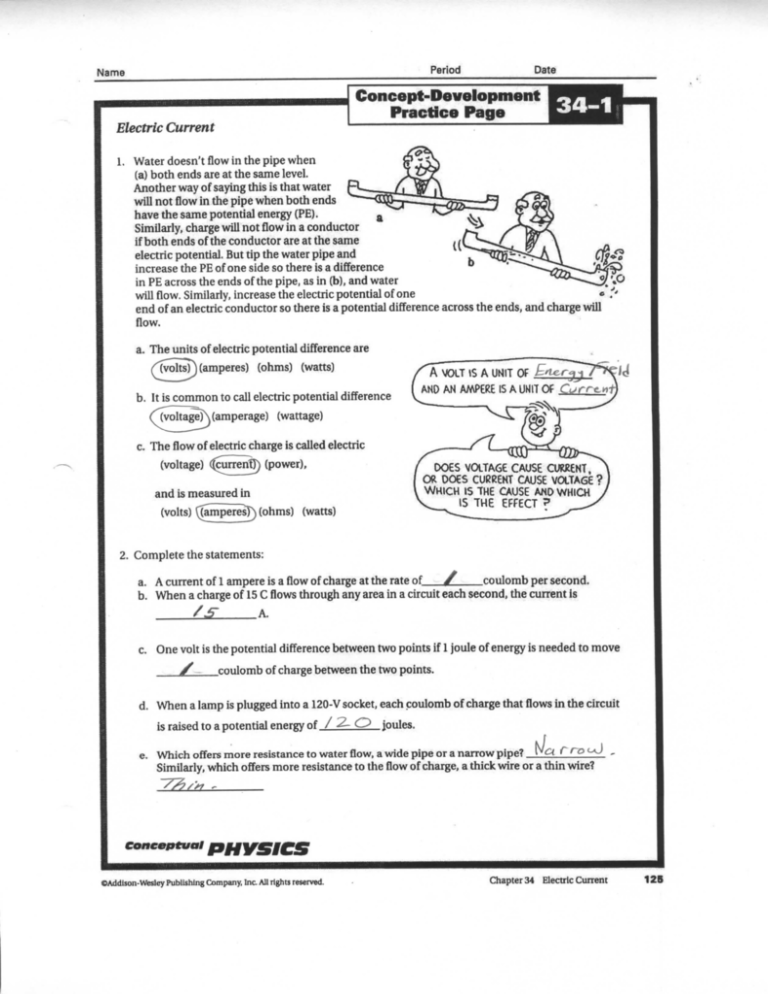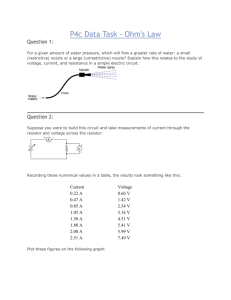
Name
Period
Date
Concept-Development
Practice Page
Electric Current
34-1
1. Water doesn't flow in the pipe when
(a) both ends are at the same level.
Another way of saying this is that water
will not flow in the pipe when both ends
have the same potential energy (PE).
Similarly, charge will not flow in a conductor
if both ends of the conductor are at the same
electric potential. But tip the water pipe and
increase the PE of one side so there is a difference
in PE across the ends of the pipe, as in (b), and water
will flow. Similarly, increase the electric potential of one
end of an electric conductor so there is a potential difference across the ends, and charge will
flow.
a. The units of electric potential difference are
(T>oltsn (amperes) (ohms) (watts)
b. It is common to call electric potential difference
• (voltage)\)
--- ==a^ (wattage)
•----c. The flow of electric charge is called electric
-~ —•
(voltage) ({current}) (power),
and is measured in
(volts) ^amperesT) (ohms) (watts)
IS A UNIT OF
AND AN AMPERE IS A UHIT OF
DOES VOLTAGE CAUSE CURRENT,
OR DOES CURREMT CAUSE VOLTAGE?
WHICH IS THE CAUSE AND WHICH
IS THE EFFECT ?
2. Complete the statements:
a. A current of 1 ampere is a flow of charge at the rate of
coulomb per second.
b. When a charge of 15 C flows through any area in a circuit each second, the current is
A
c. One volt is the potential difference between two points if 1 joule of energy is needed to move
f -
coulomb of charge between the two points.
d. When a lamp is plugged into a 120-V socket, each coulomb of charge that flows in the circuit
is raised to a potential energy of / 2- O joules.
e. Which offers more resistance to water flow, a wide pipe or a narrow pipe? • & ^ ro c '_ Similarly, which offers more resistance to the flow of charge, a thick wire or a thin wire?
Conceptual
CAddison-Wesley Publishing Company, Inc. All rights reserved.
Chapter 34 Electric Current
128
Ohm's Law
VOLTAGE OR
RESISTANCE
1. How much current flows in a 1000-ohm resistor
when 1.5 volts are impressed across it?
USE OHM'S LAW
IN THE TRIANGLE
TO FIND THE
/
QUANTITY / I
YOU WANT,
COVER THE
LETTER WITH YOUR
2. If the filament resistance in an automobile
headlamp is 3 ohms, how many amps does it draw
when connected to a 12- volt battery?
FINGER AND THE
REMAIN1N6 TWO
SHOW YOU THE
FORMULA ?
3. The resistance of the side lights on an automobile
are 10 ohms. How much current flows in them
when connected to 12 volts?
CONDUCTORS AND RESISTORS
HAVE RESISTANCE TO THE
CURRENT IN THEM.
4. What is the current in the 30-ohm heating coil of a
coffee maker that operates on a 120-volt circuit?
5. During a lie detector test, a voltage of 6 V is impressed across two fingers. When a certain question
is asked, the resistance between the fingers drops from 400 000 ohms to 200 000 ohms. What is the
current (a) initially through the fingers, and (b) when the resistance between them drops?
(a)
/ ^O
/ » /
? (b)
3 QO
*>i,/
6. How much resistance allows an impressed voltage of 6 V
to produce a current of 0.006 A?
1. What is the resistance of a clothes iron that draws a current
of 12 A at 120V?
/ O
OHM MY GOODNESS
8. What is the voltage across a 100-ohm circuit element that draws
a current of 1 A?
9. What voltage will produce 3 A through a 15-ohm resistor?
10. The current in an incandescent lamp is 0.5 A when connected to a 120-V circuit, and 0.2 A when
connected to a 10-V source. Does the resistance of the lamp change in these cases? Explain your
answer and defend it with numerical values.
Oh*, c
->pt+rc^» 4v r g.
126
Chapter 34 Electric Current
CAddlson-Wesley Publishing Company. Inc. All rights reserved.
Period
Name
Date
Concept-Development
34-2
Practice Page
Electric Power
Recall that the rate energy is converted from one form to another is power.
power =
energy converted
e£__
voltage x charge
charge
«L_—a_ _ voltage x ^ = voltage x current
The unit of power is the watt (or kilowatt). So in units form,
Electric power (watts) - current (amperes) x voltage (volts),
where 1 watt= 1 ampere x 1 volt.
THAT'S RIGHT- VOLTAGE -
1. What is the power when a voltage of 120 V drives
a 2-A current through a device?
SO ENERGY* VOLTAGE "CHARGE-
A 100-WATT BULB CONVERTS
ELECTRIC ENERGY INTO HEAT
AND LIGHT MORE QUICKLY THAN
A 25-WATT 6ULB. THAT'S WHY
FOR THE SAME VOLTAGE A IQO-WATT
BULB GLOWS BRIGHTER THAN A
25-WATT BULB'
2. What is the current when a 60-W lamp is connected
to 120V?
Q. G fr^ps
3. How much current does a 100-W lamp draw when
connected to 120V?
Q, 81>
WHICH DRAWS MORE
CURRENT-THE 100-WATT
OR THE 25-WATT BULB?
ft^s
4. If part of an electric circuit dissipates energy
at 6 W when it draws a current of 3 A, what voltage is impressed across it?
5. The equation
energy converted
p° wer =—
rearranged gives
energy converted
6. Explain the difference between a kilowatt and a kilowatt-hour.
7. One deterrent to burglary is to leave your front porch light on all the time. If your fixture contains
a 60-W bulb at 120 V, and your local power utility sells energy at 8 cents per kilowatt-hour, how
much will it cost to leave the bulb on for the whole month? Show your work on the other side of
this page.
3
Conceptual
PHYSICS
«Addison-Wesley Publishing Company. Inc. All rights reserved.
Chapter 34 Electric Current
127
Period
Name
Date
Concept-Development
35-1
Practice Page
Series Circuits
2/1
THE EQUIVALENT
RESISTANCE OF
RESISTORS IN
1. In the circuit shown at the right, a voltage of 6 V
pushes charge through a single resistor of 2 n.
According to Ohm's law, the current in the resistor
(and therefore in the whole circuit) is
SERIES is
SJMPtV THEIR
VWv—,
If a second identical lamp is added, as on the left, the 6-V battery
> must push charge through a total resistance of (£> n. The
3JI>
current in the circuit is then / A.
2.
3. The equivalent resistance of three 4-Q resistors in series is.
4. Does current flow through a resistor, or across a resistor?
Is voltage established through a resistor, or across a resistor? .
5. Does current in the lamps occur simultaneously, or does charge flow first through one lamp, then
the other, andfinallythe last in turn?
/
~
'
6. Circuits a and b below are identical with all bulbs rated at equal wattage (therefore equal resistance). The only difference between the circuits is that Bulb 5 has a short circuit, as shown.
"4.5V
a. In which circuit is the current greater?
4.5 M
u
b. In which circuit are all three bulbs equally bright?_
c.
d.
e.
f.
g.
What bulbs are the brightest?
/ r &
What bulb is the dimmest?
^
What bulbs have the largest voltage drops across them?.
Which circuit dissipates more power?
C?
What circuit produces more light?
&
conceptual
©Addison-Wesley Publishing Company. Inc. All tights reserved.
Chapter 35 Electric Circuits
129
Parallel Circuits
1. In the circuit shown below, there is a voltage drop of
6 V across each 2-11 resistor.
THE SUM OF THf ClMtEMTS (H THE
TWO 6RAMCH PATHS K3UW.S THE
CUMEHT KfOK a WVIWS.
a. By Ohm's law, the current in each
resistor is _
_A.
zn
'6V
b. The current through the battery is
the sum of the currents in the
A.
resistors,.
c. Fill in the current in the eight blank
spaces in the view of the same
circuit shown again at the right.
2. Cross out the circuit below that is not equivalent to
the circuit above.
3. Consider the parallel circuit at the right.
a. The voltage drop across each resistor is
<&
y.
b. The current in each branch is:
2-tl resistor _J|_A
2-ii resistor -^ A
THE EQUIVALENT
RESISTANCE OF A
PAIR OF RESISTORS
IN PARAUEL IS
THEIR PRODUCT
DIVIDED 6Y
THEIR
1-n resistor Je_A
b. The current through the battery
equals the sum of the currents which
equals / *- A.
c. The equivalent resistance of the circuit
equals /2- n.
130
Chapter 35 Electric Circuits
OAddison-Wesley Publishing Company, Inc. All rights reserved.
Period
Name
Date
Concept-Development 35-2
OJ «.
Practice Page
Compound Circuits
1. The initial circuit, below left, is a compound circuit made of a combination of resistors. It is
reduced to a single equivalent resistance by the three steps, the circuits to its right, a, b, c. In step
a, show the equivalent resistance of the parallel 4-fl resistors. In step b combine this in series with
the 3-fl resistor. In step c, combine the last parallel pair to obtain the equivalent resistance of the
circuit. (Note the similarity of this circuit and Figure 35.10 in your textbook.)
R=
—WvL_AMr-
4.H.
-
Sfl
A/W
Initial Circuit
=> —-VW—
5A
b.
a.
2. The circuit below is similar to Figure 35.11 in your textbook. In three successive steps, as in
Question 1, replace each pair of resistors by a single resistor of equivalent resistance.
R=
3-*.
(A
M/vV-l
3. Find the equivalent resistance of these three circuits.
CAddison-Wesley Publishing Company, Inc. All rights reserved.
Chapter 35 Electric Circuits
131
4. The table beside circuit a below shows the current through each resistor, the voltage across each
resistor, and the power dissipated as heat in each resistor. Find the similar correct values for
circuits b, c, and d, and put your answers in the tables shown.
2SI
RESISTANCE CURRENT'« VOLTAGE = POWER
2A
4/1
6-rt.
2A
2A
2A
4V
8W
8V
16 W
2<4W
12V
I2v
2/1
RESISTANCE CURRENT" VOLTAGE = POWER
2/1
'6V
fe/L
RESISTANCE CURRENT" VOLTAGE = POWER
6J1
3/L
6
RESISTANCE CURRENT" VOLTAGE = POWER
I/5/?
*,.*>»'
Conceptual
132
Chapter 35 Electric Circuits
OAddlson-Wesley Publishing Company, Inc. All rights reserved.








